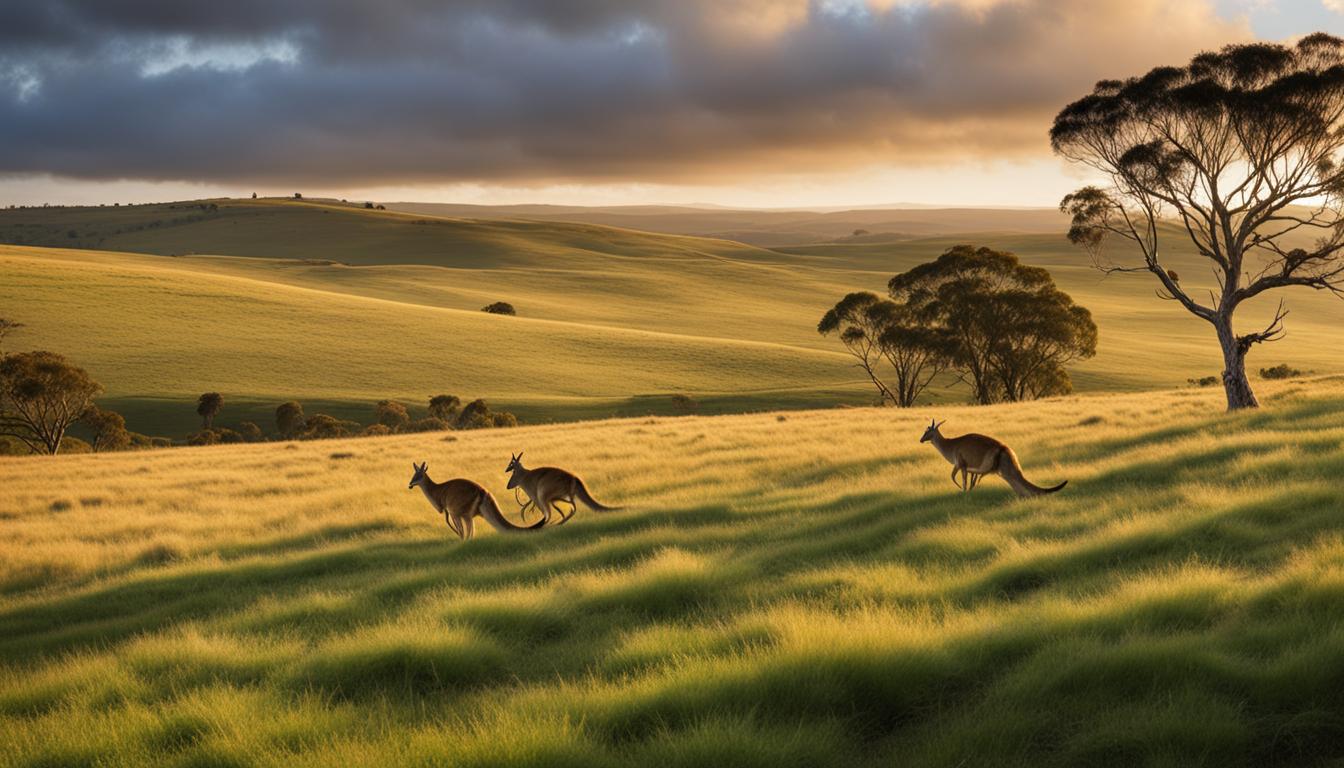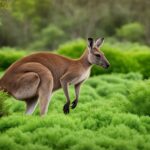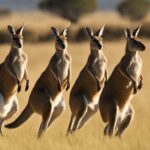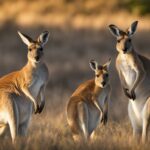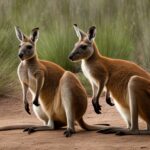Welcome to our exploration of kangaroos in the wild! In this article, we will delve into their natural environment, habitat, and population. Kangaroos, known for their unique hopping movements and pouches, are fascinating creatures that inhabit various regions of the world. Let’s dive in and discover more about these iconic marsupials.
With over 60 different species, kangaroos are diverse in their characteristics and behaviors. The main kangaroo species, including the antilopine kangaroo, western gray kangaroo, red kangaroo, and eastern gray kangaroo, have distinctive traits and adaptations that allow them to thrive in their environments.
Primarily, kangaroos are found in Australia, where they have established a significant population. In fact, in 2011, a staggering 34.3 million kangaroos were recorded in the country. However, kangaroos can also be found in other countries like Papua New Guinea and New Zealand, albeit in smaller numbers.
Are you ready to explore the origin and evolution of kangaroos? In the next section, we will delve into their fascinating journey and how they adapted to their new homes. Stay tuned!
The Origin and Evolution of Kangaroos
Kangaroos have a fascinating history that dates back to the ancient supercontinent of Gondwanaland. This landmass comprised what is now South America, Africa, India, Australia, and Antarctica. It was during this time that kangaroos first emerged, evolving alongside other unique species. However, when Gondwanaland began to break apart around 180 million years ago, kangaroos found themselves separated from their original habitat.
“The migration of kangaroos to Australia was a pivotal moment in their evolution,” explains Dr. Sarah Thompson, a leading expert in marsupial biology. “As they adapted to the diverse landscapes of Australia, kangaroos underwent significant changes in their anatomy and behavior, allowing them to thrive in their new environment.”
The isolation of Australia provided an ideal setting for kangaroos to evolve independently from other mammalian species. Over time, they developed their iconic hopping movement and specialized digestive system, which enables them to efficiently extract nutrients from the vegetation they consume.
Today, kangaroos are considered native to Australia and have become an integral part of the country’s unique biodiversity. Their evolution is closely tied to the geographical history of the continent, highlighting the remarkable adaptability and resilience of these marsupials.
Kangaroo Habitat and Adaptations
Kangaroos are highly adaptable creatures, capable of thriving in a variety of habitats. While they traditionally inhabit bushlands and woods, kangaroos have also successfully adapted to diverse environments such as grasslands, coastal heathlands, and forests. Their ability to survive and flourish in different ecosystems is a testament to their remarkable adaptations.
One of the most notable adaptations of kangaroos is their unique ability to go for long periods without drinking water. Their bodies are highly efficient at conserving water, allowing them to survive in arid regions where water sources may be scarce. Kangaroos obtain most of their water intake from the moisture content in plants and have developed physiological mechanisms to minimize water loss.
Another distinctive characteristic of kangaroos is their incredible hopping movements. These adaptations enable them to cover long distances efficiently while conserving energy. Kangaroos use their strong hind legs to propel themselves forward in a series of powerful jumps, reaching speeds of up to 40 miles per hour. This hopping motion is not only an efficient means of locomotion but also helps them evade predators and navigate their natural environment.
Kangaroo Adaptations
Kangaroos possess several adaptations that allow them to survive and thrive in their respective habitats. These adaptations include:
- Pouches: Female kangaroos have pouches where they carry and nurture their young, known as joeys. This unique adaptation allows the joeys to develop and grow in a safe and protected environment, while the mother is free to forage for food.
- Dental Structure: Kangaroos have well-developed teeth designed for grinding vegetation. Their complex dental structure enables efficient chewing and digestion, allowing them to extract maximum nutrients from their plant-based diet.
- Nocturnal Behavior: Many species of kangaroos have evolved to be primarily active during the crepuscular period, which is the time between sunset and complete darkness. This behavioral adaptation helps them avoid extreme temperatures and conserves energy during the hottest parts of the day.
A Visual Representation of Kangaroo Adaptations
| Adaptation | Description |
|---|---|
| Pouches | Female kangaroos have pouches where they carry and nurture their young, known as joeys. |
| Dental Structure | Kangaroos have well-developed teeth designed for grinding vegetation, allowing for efficient digestion. |
| Nocturnal Behavior | Many kangaroo species are primarily active during the crepuscular period to avoid extreme temperatures and conserve energy. |
Kangaroo Distribution outside of Australia
Kangaroos are primarily found in Australia, but they can also be found in small populations in other countries. One such country is Papua New Guinea, located just north of Australia. In Papua New Guinea, kangaroos can be found in the highlands and low-lying areas. They have adapted to the diverse landscapes of the country, including mountains, grasslands, and forests. While the kangaroo population in Papua New Guinea is not as large as in Australia, their presence contributes to the biodiversity of the region.
Another country where kangaroos can be found is New Zealand. In New Zealand, kangaroos are considered an introduced species, as they were brought to the country in the 19th century for hunting purposes. Today, there are small populations of kangaroos in certain parts of the country, such as Kawau Island and Tiritiri Matangi Island. The kangaroos in New Zealand have adapted to the local environment and can be seen grazing in open fields and forests.
While there have been claims of kangaroo sightings in parts of America, such as Texas and Wisconsin, these claims have not been verified. It is uncertain whether kangaroos have established populations in these areas or if the sightings were of escaped or released captive kangaroos. Regardless, the presence of kangaroos outside of Australia adds to their allure as unique and fascinating creatures.
Table: Kangaroo Distribution outside of Australia
| Country | Main Regions | Population Size |
|---|---|---|
| Papua New Guinea | Highlands and low-lying areas | Small populations |
| New Zealand | Kawau Island, Tiritiri Matangi Island | Small populations |
| America | Texas, Wisconsin (unverified claims) | Unknown |
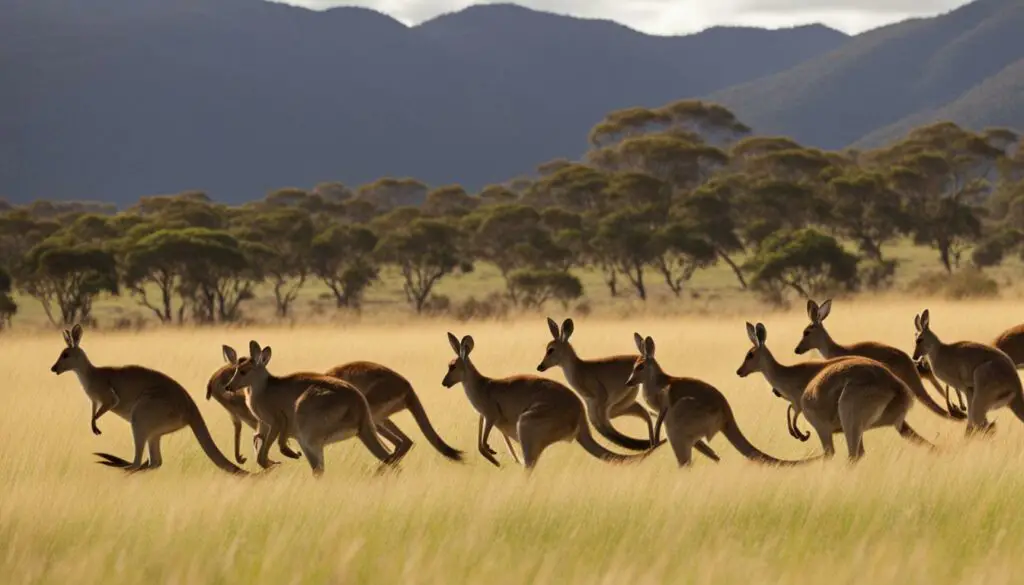
Kangaroo Behavior and Ecology
Kangaroos exhibit fascinating behavior and have unique characteristics that enable them to thrive in their natural environment. Understanding their behavior and ecology provides valuable insights into these remarkable creatures.
Kangaroo Behavior
Kangaroos are primarily active during dusk and dawn, known as crepuscular behavior. During these periods, they engage in various activities such as foraging for food, socializing, and moving between their resting and feeding grounds. They are herbivores, grazing on a diverse range of vegetation including grass, leaves, ferns, flowers, fruit, and moss. This diet allows kangaroos to adapt to different habitats, ensuring their survival across various ecosystems.
Kangaroos possess distinctive communication methods. When alarmed, they emit hissing and growling sounds to intimidate potential threats. Female kangaroos communicate with their offspring through clicking noises, which help maintain close bonds within their groups. Males exhibit courtship behavior by ‘chuckling,’ a unique vocalization that helps attract females during the mating season.
Kangaroo Ecology
Kangaroos play a crucial role in the ecosystem as grazers and seed dispersers. Their feeding habits contribute to maintaining vegetation balance and seed propagation. Through their grazing activities, kangaroos prevent the dominance of certain plant species and create opportunities for the growth of diverse flora. Additionally, the seeds ingested by kangaroos are later dispersed through their feces, aiding in the regeneration of plants across their habitat.
While kangaroos have few natural predators, they face threats from Dingoes, humans, and Wedge-tailed Eagles. Human activities, such as habitat destruction and the introduction of non-native herbivores, pose significant challenges to their survival. Conservation efforts are therefore essential to ensure the preservation of these iconic animals and the ecosystems they inhabit.
| Threats to Kangaroo Ecology | Conservation Efforts |
|---|---|
| Habitat loss due to human activities | Conservation organizations like Bush Heritage work towards protecting kangaroo populations by restoring natural landscapes and preserving their habitats. |
| Competition with introduced herbivores | Efforts are made to reduce competition by managing populations of introduced herbivores and implementing sustainable grazing practices. |
| Predation by wild dogs and foxes | Controlling feral predators through targeted management strategies helps mitigate the predation risks faced by kangaroos. |
By understanding kangaroo behavior and supporting conservation initiatives, we can contribute to the preservation of these fascinating animals and the delicate ecosystems in which they thrive.
Threats to Kangaroos and Conservation Efforts
Kangaroos, like many other wildlife species, face a range of threats that endanger their populations and habitats. The decline in kangaroo populations is primarily attributed to habitat loss caused by human activities such as deforestation, urbanization, and agriculture. These activities result in the destruction and fragmentation of kangaroo habitats, limiting their access to food and water sources.
The introduction of non-native herbivores, such as rabbits and goats, also poses a significant threat to kangaroos. These invasive species compete with kangaroos for resources, leading to decreased food availability and increased competition for survival. Additionally, predators such as wild dogs and foxes pose a threat to kangaroos, particularly to their young, further contributing to population decline.
To address these threats and ensure the conservation of kangaroos, various initiatives and organizations are actively working towards protecting kangaroo populations and their habitats. Conservation efforts include the establishment of protected areas, wildlife corridors, and habitat restoration projects.
| Threats to Kangaroos | Conservation Efforts |
|---|---|
| Habitat loss due to deforestation, urbanization, and agriculture | Establishment of protected areas and wildlife corridors |
| Competition with introduced herbivores | Control measures to reduce the population of invasive species |
| Predation by wild dogs and foxes | Predator control programs to protect kangaroo young |
Organizations such as Bush Heritage work towards the conservation and sustainable management of kangaroo populations. They collaborate with local communities, government agencies, and researchers to implement effective conservation strategies. By raising awareness, conducting research, and engaging in conservation activities, these organizations strive to protect kangaroos and ensure their long-term survival in the wild.
Conserving Kangaroos for Future Generations
The conservation of kangaroos is essential not only for their intrinsic value as unique and iconic species but also for the ecological balance they maintain in their habitats. As grazers, kangaroos play a crucial role in shaping vegetation communities. They help disperse seeds, promote plant regeneration, and maintain biodiversity by selectively feeding on different plant species.
Conservation efforts need to address not only the direct threats to kangaroos but also the underlying causes, such as unsustainable land-use practices, climate change, and human-wildlife conflict. By adopting sustainable agricultural practices, promoting responsible land management, and reducing greenhouse gas emissions, we can contribute to the long-term conservation of kangaroos and their habitats.
Ultimately, protecting kangaroos requires a collaborative and holistic approach that involves the participation and support of individuals, communities, governments, and conservation organizations. By working together, we can ensure the survival of kangaroo populations for future generations to admire and appreciate.
Conclusion
Kangaroos are fascinating creatures that can be found in the wild primarily in Australia, with smaller populations in other countries. With their unique adaptations and behaviors, kangaroos have thrived in diverse habitats such as bushlands, grasslands, and forests. These iconic animals play vital roles in the ecosystem as grazers and seed dispersers, contributing to the balance of their natural environment.
However, kangaroos face significant threats due to human activities and the introduction of non-native species. Habitat loss, competition with introduced herbivores, and predation by wild dogs and foxes pose challenges to kangaroo populations. In order to ensure the survival of kangaroos for future generations, it is crucial to support conservation efforts.
Conservation initiatives aim to protect kangaroo populations by reducing competition, controlling feral predators, and restoring natural landscapes. Organizations like Bush Heritage are actively involved in the conservation and sustainable management of kangaroos. By understanding the importance of kangaroo habitat and supporting these conservation measures, we can contribute to the preservation of these remarkable animals in the wild.
What is the current population status of kangaroos in their natural habitat?
The remaining kangaroo population in their natural habitat is estimated to be around 50 million across Australia. However, this number has been decreasing due to factors such as habitat loss and hunting. Conservation efforts are being made to protect and sustain the kangaroo population for future generations.
FAQ
Where can kangaroos be found in the wild?
Kangaroos primarily inhabit Australia, but they can also be found in countries like Papua New Guinea and New Zealand.
What is the origin and evolution of kangaroos?
Kangaroos originated in South America as part of the super continent Gondwanaland, and later migrated to Australia where they adapted to their new habitat.
What is kangaroo habitat and how have they adapted?
Kangaroos traditionally inhabit bushlands and woods, but they have also adapted to other habitats like grasslands and forests. They have unique adaptations such as the ability to go for months without drinking water and their hopping movements.
Are there kangaroos outside of Australia?
Yes, there are small populations of kangaroos in other countries like Papua New Guinea and New Zealand.
What is kangaroo behavior and how do they contribute to the ecosystem?
Kangaroos are most active during dusk and dawn. They are herbivores, feeding on grass and a variety of vegetation. They have unique behaviors like hissing, growling, and females communicating with their offspring through clicking noises. Kangaroos play an important role in the ecosystem as grazers and seed dispersers.
What are the threats to kangaroos and what conservation efforts are being made?
Kangaroos face threats such as habitat loss, competition with introduced species, and predation. Conservation efforts aim to protect kangaroo populations by reducing competition, controlling predators, and restoring natural landscapes.
Why is kangaroo conservation important?
Kangaroos are fascinating animals that need protection to ensure their survival for future generations. By understanding their habitat and supporting conservation initiatives, we can contribute to the preservation of these iconic creatures.

